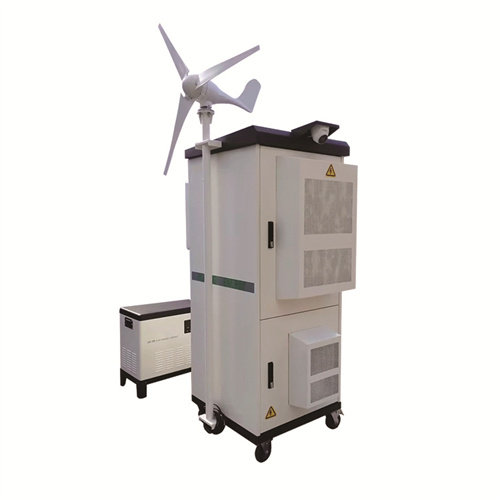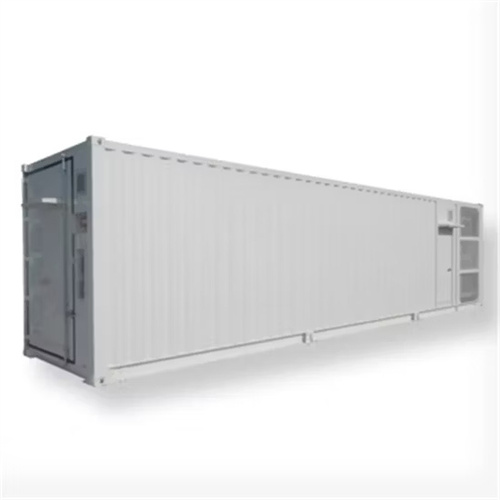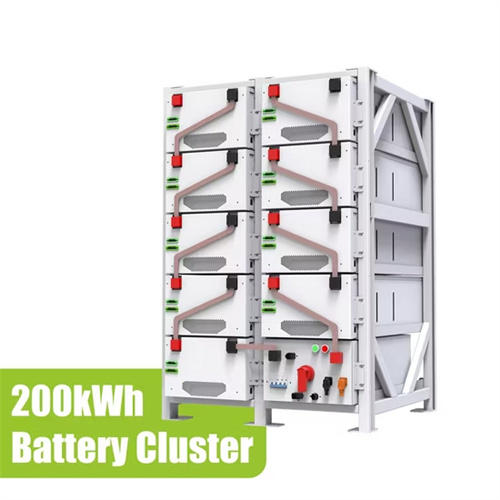Norway solar thermochemical energy storage

Electricity-assisted thermochemical sorption system for seasonal solar
Beside the active heating technologies, thermal energy storage is strategically important for the future of low carbon heating. The seasonal solar thermal energy storage (SSTES) is aimed to achieve ''free'' heating by storing solar heat in summer and releasing heat in winter [2].One of the key performance indicator of a SSTES is the volumetric energy density.

Thermochemical Energy Storage for Concentrated Solar Power
Objective. The overall objective of the TCSPower project is to realise a new, efficient, reliable and economic thermochemical energy storage (TCS) for concentrated solar power plants which has the capability to contribute significantly to further cost reduction of regenerative electricity production.

Thermochemical energy storage
Among all three types'' solar TES systems, thermochemical energy storage system is particularly suitable for long term seasonal energy storage [120,255,256]. It is due to the fact that TCS utilizes a reversible chemical reaction which involves no thermal loss during storage [257–260], as the products can be stored at ambient temperature [28].

Heatcube: Thermal Energy Storage Solution
Enabling energy load shifting, by exploiting energy from renewable sources when it''s abundant, and storing it for later use. Thermal Energy Storage (TES) solutions, like Heatcube, ensure energy is consumed at its greenest and lowest cost.

(PDF) A Review of Thermochemical Energy Storage Systems
Solar energy [131 – 133] or micro combined heat and power (CHP) [134–136] are examples of heat sources. MVC cycle and thermo chemical storage system have the same condenser, evaporator and

4E analysis and parameter study of a solar-thermochemical energy
In this work, the new solar-thermochemical energy storage (Solar-TCES) CCHP system is designed and proposed. Based on the CSP-CaL power plant, the cooling and heating subsystems are added. Meanwhile, the operation is divided into 8 h during the day and 16 h at night, which is closer to the actual effective use of solar energy. In the system

Transitional season solar energy storage using physical
Seasonal heat storage is a method to postpone use of solar energy from periods of availability to periods with the demand. Sorption heat effect of desiccant materials, such as silica gel, molecular sieve, et al., can be used for seasonal solar energy storage without heat loss caused by

Solar Thermochemical Energy Storage | AIChE
Because the purpose of the chemical process is energy storage, a critical component of the subsystem is the storage tanks. Thermochemical storage mechanisms have a higher energy density than thermal methods, which could

Transitional season solar energy storage using physical
Seasonal heat storage is a method to postpone use of solar energy from periods of availability to periods with the demand. Sorption heat effect of desiccant materials, such as silica gel, molecular sieve, et al., can be used for seasonal solar energy storage without heat loss caused by temperature difference (like water pond storage).

Electricity-assisted thermochemical sorption system for seasonal solar
The present paper investigated the seasonal solar thermal energy storage (SSTES) using solid-gas thermochemical sorption technology that has inherently combined function of heat pump and energy storage. The thermochemical reactions that can discharge heat at a higher temperature usually requires a relatively higher desorption temperature during

Thermal energy storage technologies for concentrated solar power
Thermal energy storage provides a workable solution to the reduced or curtailed production when sun sets or is blocked by clouds (as in PV systems). The solar energy can be stored for hours or even days and the heat exchanged [104] before being used to generate electricity [103].

Thermochemical Energy Storage | SpringerLink
Thermochemical energy storage (TCES) is considered the third fundamental method of heat storage, along with sensible and latent heat storage. TCES concepts use reversible reactions to store energy in chemical bonds. Neises, M., et al. ''Solar-heated rotary kiln for thermochemical energy storage'', Solar Energy, Vol. 86, pp. 3040–3048, 2012.

Biomimetic low carbonization efficient solar-driven thermochemical
Hydrogen energy is currently recognized by most scholars as an efficient and clean energy source for the future [1], [2].Hydrogen production from renewable energy [3], [4] sources, especially solar energy [5], [6], is considered as a promising and clean pathway [7], [8] has the potential to meet energy demand while reducing carbon emissions [9], [10].

Solar calcium-looping integration for thermo-chemical
Energy collection, conversion and storage, renewable energy, CSP, Solar Storage . SOCRATCES will be built on previous R&D results of the project partners. indicating that the CaL process can be integrated into CSP plants for thermochemical energy storage and power generation by means of a simple closed CO2 loop.

A review on thermochemical seasonal solar energy storage
In the current era, national and international energy strategies are increasingly focused on promoting the adoption of clean and sustainable energy sources. In this perspective, thermal energy storage (TES) is essential in developing sustainable energy systems. Researchers examined thermochemical heat storage because of its benefits over sensible and latent heat

Seasonal Thermal Energy Storage Using Sand Batteries
The global shift from fossil fuels to renewable energy sources necessitates effective energy storage solutions to address the intermittent nature of renewable power. This thesis investigates the feasibility and economic viability of using sand batteries for seasonal thermal energy storage in Northern Norway.

ITChES – Integration of ThermoChemical Energy Storage
Water-sorption thermochemical energy storage (TCES) systems have potential as a flexible, compact, and sustainable solution to this, however the technology readiness level is still low. Compared to storage media such as phase change materials, PCMs, TCES offers the advantage of loss-free, long-term (up to weeks or even months) storage at room

Thermochemical Energy Storage
In concentrating solar power (CSP) applications, Thermochemical Energy Storage (TCES) refers to the process of chemically storing and releasing concentrated sunlight to produce solar electricity. TCES technologies allow CSP production to continue after the sun goes down and during cloudy conditions.

Solar Calcium looping integRAtion for Thermo-Chemical
C Ortiz, MC Romano, JM Valverde, M Binotti, R Chacartegui, Process integration of Calcium-Looping thermochemical energy storage system in concentrating solar power plants, Energy 155, 535-551 2018 C Ortiz, R Chacartegui, JM Valverde, A Alovisio, JA Becerra, Power cycles integration in concentrated solar power plants with energy storage based on

Development of a Thermo-Chemical Energy Storage for
Within the Task 32 "Advanced storage concepts for solar and low energy buildings" of the International Energy Agency (IEA) the "MonoSorp-Concept" was assessed as one of the most promising concepts.

3D Unsteady CFD Simulation of Seasonal Solar Thermochemical
Solar energy storage has been an extensive research topic among the several thermal energy applications over the past three decades. Thermal energy storage (TES) systems in general, improve the energy efficiency of systems and sustainability of buildings by reducing the mismatch between supply and demand, and can substantially increase the solar fraction.

Thermal energy storage
SINTEF has knowledge on technologies for thermal storage tailored to different applications and temperature levels ; Modelling of thermal systems with integrated thermal energy storage for optimal design of the system as a whole ; Optimal control of systems with energy storage; Heat exchanger design. Typical projects for us are:

Solar thermochemical fuels: Present status and future prospects
The production of syngas by simultaneous splitting of direct-air-captured CO 2 and H 2 O via a solar thermochemical redox cycle is a competitive alternative to electrolysis-based pathways. Isothermal or near-isothermal operation using high-entropy oxides that are readily available, robust, and flowable is recommended on the basis of practical considerations

Dispatchability of solar photovoltaics from thermochemical energy storage
Solar photovoltaics (PV) plants are one of the most promising markets in the field of renewable energy [1], with a PV market growth year-on-year of 29% in 2017 [2].The size of PV Plants varies depending on the application [3]: from Pico PV systems of few watts used for off-grid basic electrification, to Grid Connected Centralized systems in the range of MWs [4].

A review on thermochemical seasonal solar energy storage
This study examines different thermochemical thermal energy storage (TES) technologies, particularly adsorbent materials used for seasonal heat storage in solar-powered building systems. This evaluation is confined to thermochemical energy storage devices with charging temperatures less than 140 °C.

6 FAQs about [Norway solar thermochemical energy storage]
Can thermochemical thermal energy storage be used in solar-powered buildings?
This study examines different thermochemical thermal energy storage (TES) technologies, particularly adsorbent materials used for seasonal heat storage in solar-powered building systems. This evaluation is confined to thermochemical energy storage devices with charging temperatures less than 140 °C.
Why is thermochemical heat storage important?
Researchers examined thermochemical heat storage because of its benefits over sensible and latent heat storage systems, such as higher energy density and decreased heat loss. Solar energy is a promising alternative among the numerous renewable energy sources.
Are thermochemical materials a good alternative to sensible and latent heat storage?
This, paired with a much greater thermal energy density when compared to sensible and latent heat storage methods, as shown in Fig. 1, makes thermochemical materials (TCM) an appealing alternative for mid-to-long-term heat storage solutions . Energy density comparison of different TES
What is underground thermal energy storage?
Underground thermal energy storage (UTES) is a strategic approach to managing energy in renewable systems or other industries, enabling the storage of heat or cold in natural underground formations to align energy availability with demand. This technology is pivotal in settings where significant, seasonal energy storage is needed.
What is thermochemical energy storage?
Thermochemical energy storage is one of the non-sensible heat energy storage technology, that accounted more papers, 50 papers published from 2013 to 2018. Almost the 12% of the overall papers has been issued as articles of thermochemical storage.
What is borehole thermal energy storage?
Borehole Thermal Energy Storage (BTES) is a system that stores heat directly in the rock underground without exchanging any fluid with the ground. An example is the system at Falstadsenteret, a historical museum in Levanger, which includes a heat pump and nine deep boreholes.
Related Contents
- Liberia solar thermochemical energy storage
- Norway fabric energy storage
- Solar energy storage system price Åland
- Energy storage solar panels Kuwait
- Energy storage system solar Macao
- Norbornadiene solar energy storage Ghana
- Uruguay energy storage for solar power
- Hungary smart solar energy storage
- Belarus solar energy storage future 2024
- Solar energy storage types Georgia
- Home solar energy storage Thailand
- Smart solar energy storage Sint Maarten